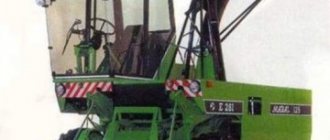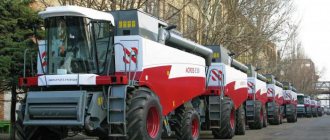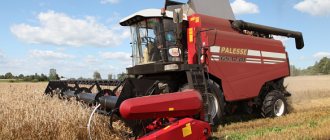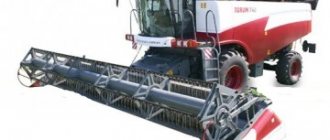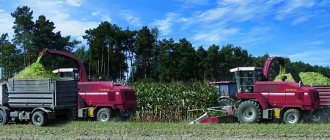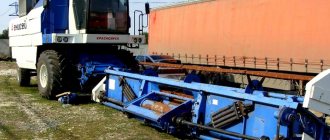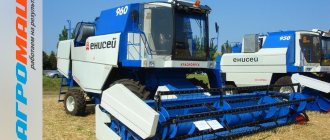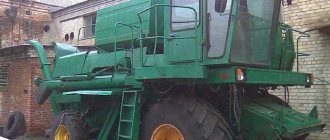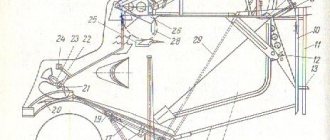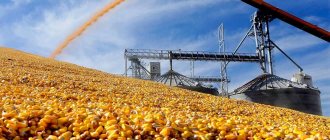Types of forage harvesting equipment
A forage harvester is an agricultural equipment that is made for mowing sown or natural stem crops, picking up the withered cuttings, chopping them and sending them to a specially designated place for collection. It is used when preparing silage, haylage, hay or grass meal. It is equipped with a pick-up and headers, which, depending on the type of harvest, are:
- Solid cut for herbaceous plants.
- For tall stems.
- Ruchev.
- Drums.
Shredders are presented:
- Drum. With knives on top of a drum, the horizontal axis of which is located at right angles to the movement of the crushed material.
- Or disk type. With radical disc knives, the axis of which is parallel to the movement of the material.
Forage harvesters are divided into three types:
- Trailed. They move using their own diesel engine, wheels or tracks.
- Self-propelled. They are coupled to the drive unit via a towbar or power take-off shaft. Used with powerful tractors.
- Semi-mounted. In conjunction with walk-behind tractors or mini-tractors. Repurposed for households and small agricultural firms.
The wheels and working equipment of self-propelled vehicles are driven mechanically or hydraulically.
Comparison of combines
The greatest productivity and efficiency when preparing silage will be provided by the DON 680M combine with a throughput capacity of 100 t/h and a powerful engine. It should be chosen when there are large areas that require processing. The E281 combine is ideal for harvesting corn, it is quite compact and has decent throughput. A more versatile cleaning product, but at the same time has less power.
The main task of PSP 10 is to harvest sunflowers. The presence of special functionality allows you to carry out a full cycle of seed processing. The combine is relatively mobile and has good performance for harvesting sunflowers. OUR 873 is also designed for sunflower harvesting. Its distinctive feature is the ability to work in different cultivation zones with minimal losses.
The Ros-2 combine is designed for mowing technological crops. Its advantages are small dimensions, versatility and mobility in movement. However, the combine does not have its own engine for movement, so it works in tandem with a tractor.
The Krone Big X-650 combine harvester is the most modern and technologically advanced of the presented models. It has maximum versatility, as it has a set of special attachments for working with any crops. The combine reaches speeds of up to 40 km/h, which allows you to quickly move from one place to another. At the same time, the Krone Big X-650 is the most expensive of the presented models.
KPD-3000 is a simple trailed forage harvester. The design provides protection for the knives from flying stones, and there are also various operating modes. One of the most budget options.
How to do it yourself
You can make a small feed harvester yourself. To do this, use any tractor, for example the T-40, which contains ready-made assemblies such as an engine, wheels, driver’s seat and other mechanisms. To convert it into a combine, you need to add a header for mowing grass vegetation. A suitable device is KPKU-75 with a working width of 3 m. For balancing, a counterweight in the form of a tank of water or gas cylinders attached to the rear of the machine is used.
Prices
The cost of new combine harvesters from the manufacturer depends on the model, basic configuration, country of manufacture, delivery, and the presence of an official dealer in the region.
On the secondary market, prices for used models fluctuate. Thus, a Maral-125 manufactured in 1992 in working condition with a header without several chains and a windrower can be purchased for 550 thousand rubles, a model produced in 2007 can be purchased for 990 thousand rubles.
A trailed KDP-3000 Polesie with 3 sets of headers manufactured in 2004 is offered for 1 million rubles, and a German Krone Big X-650 from 2007 is offered for 9 million rubles.
For seasonal work, farmers often rent agricultural equipment. The rental price is calculated taking into account the time or shift worked, the area of the area being processed, soil conditions, weather conditions and the availability of a machine operator.
History of the creation of the combine
The history of forage harvesting equipment begins in the Soviet period in 1949, when the first trailed SK-1.2 for silage harvesting was produced. In 1953 it was modified into SK-2.6. A more powerful machine, over 50,000 units were produced in four years. In 1964, they began producing KS-2.6 forage harvesters, and in 1972, the KS-1.8 Vikhr combine harvester. The father of self-propelled vehicles is the KSG-2.6, invented on the basis of the SKD-5R Sibiryak machine for harvesting rice crops. The most popular in the USSR were five combined units for collecting feed:
- Self-propelled KSK-100.
- Trailed unification KPKU-75. It is aggregated with the T-150K tractor machine.
- Trailed KPI-2.4. With MTZ-80/82 or DT-75.
- KSS-2.6. With T-150K.
- Tracked self-propelled vehicle KSSF-70.
Specifications
The design of forage harvesters includes:
Attachments operate hydraulically and include:
- Dividers. They can be active or passive. The second ones are mounted on the header for collecting forage and grass crops. They are represented by a multi-faceted wedge for deflecting the cut masses onto the header. And the first ones are designed for cutting tangled plants and are equipped with two knives and auger dividers for breaking knots.
- Reel. Designed to supply the mowed masses to the device for cutting, holding and feeding them to the assembly unit. Long-stemmed crops are harvested using a rigid blade, herbaceous crops are harvested using a copying method, and grain crops are harvested using an eccentric method.
- Cutting apparatus of a platform header. It is represented by two knives of appositive movement, driven by a swinging washer or a curved slider device.
- Rotary harvester. It is used for mowing corn crops and sunflowers. It consists of side augers, a middle passive divider for lifting crops, disk cutting mechanisms, and drums for feeding bevels to the feeding unit.
- Picker. It is hung on the place of the header for harvesting dried grass from the windrows. It can be drum-type with spring-loaded fingers or platform-type. The second one copies the terrain with the help of shoes that vary in height.
Metal catchers. This is a protective device for the combiner from foreign bodies. It consists of a metal detector sensor, an actuator, an electronic unit, and a quick stop electromechanism.
Feeding mechanisms. Used for compaction and transport of plant masses to grinders.
Shredding devices are designed for cutting plants from 40 to 200 mm in length, re-grinding corn grain or fodder crops, feeding crushed masses into transport:
- Drum chopper. Includes a cylinder from 35 cm to 2.6 m in length, from 63 cm to 80 cm in diameter with shear plate and knives. Involves from three to a dozen knives with rotation of different frequencies from 850 to 1,100 rpm. Sometimes perforated recutters, single-finger or two-finger recutters are used.
- Disc chopper. This is a flat disk with a dozen blades arranged radially, with a diameter of 106 to 110 cm and a peripheral speed of 60 m/s. It is equipped with blades for moving plants, recutters, pallets, guide trays and foot beams.
Popular combine harvester models
- Jaguar. The car is of German origin under the Klaas brand. According to statistics, it is the most purchased combine harvester. It is designed for collecting silage, mowing grassy and tall crops. Equipped with a Mercedes benz engine, a self-sharpening device, triangular knives, and climate control in the operator room. It has a power of 303,000 W, a header length of 3 m, and four rollers. It is capable of cutting crops with a height of 0.4 to 1.7 cm and moves at a speed of 16 to 40 km/h.
- KSK-600 is a resource-intensive, cheap station wagon from Polesie. The productivity of the equipment is up to 108,000 kg/hour when harvesting silage, up to 39,000 kg when harvesting fresh feed. Equipped with a five-roll feeding mechanism with a hydraulic drive, adjustable cutting height from 0.6 to 3 cm, a relief copier, metal and stone detectors, a 3/5 m reaping unit. Weighs 7,800 kg, moves at a speed of 12 to 20 km/h and has a power of 235 horses. The fuel tank of the unit holds 400 liters.
- Silage harvester KSK-100A from Gomselmash (Polesie). Equipped with a 200-horsepower engine, a five-roller mechanism, a drum chopper, a fully glazed operator’s room, and a six-cylinder power unit YaMZ-238 or SMD-72. Fuel consumption ranges from 162 to 168 g/l. With. h. Productivity – 25 kg/s. Cleaning speed – 12 km/h. The cutting height is from 6 cm, and the length of the workpiece is from 0.5 to 10 cm.
- If we talk about trailed forage harvesting agricultural machinery, then first of all about the KDP-3000. It is used in conjunction with a tractor and is driven by its PTO. It is a universal machine equipped with a disk crusher, a stone catcher, a metal catcher, and a 2/3/3.4 m grab. Installation power is from 110,000 to 185,000 W, productivity is 43,000 kg/hour, cutting height is 6/12 cm, weight – 3.1 t.
- The modern market leader among forage harvesters is the RSM 1401 from the world-famous Rostselmash company. It has a capacity of 18 km/h or 140,000 kg. Equipped with triangular blades, a large number of options, a two-seat Comfort Cab body, an Adviser information module and a panoramic windshield. Engine power – 400 horses, grip – 6,000 mm. Fuel tank capacity – 1,060 l, weight – 11,000 kg. Cut length – from 0.4 to 1.7 cm, moving speed – 30 km/h.
- The self-propelled forage harvester Maral 125 is a maneuverable agricultural machinery with a drum crusher, a metal and stone catcher, a single cabin and a large selection of options. Has a power of 170 hp. With. The ejection range is 3,900 mm, the header is 2.1/2.8/4.2 m. It moves at speeds of up to 20 km/h and runs on a fuel tank that holds 0.185 cubic meters.
High-quality harvesting: review of forage harvesters
Equipment Livestock Crop production August 11, 2020
Text: Yulia Belopukhova, agronomist, Ph.D. biol. sciences
In the current economic conditions, supplies of feed and feed additives have decreased slightly, while their costs have begun to increase significantly. In such a situation, it is important for agricultural producers to increase their own production of feed, especially haylage and silage. For their high-quality harvesting in the largest volume, reliable harvesting equipment is required.
Now the state provides support for the purchase of specialized agricultural machines. Of course, the conditions and opportunities for agricultural producers are different, however, when deciding to purchase units on credit or leasing, it is more advisable to pay attention to modern machines for harvesting corn, sunflowers, seeded cereals and leguminous forage grasses up to 1.5 m high. New equipment must be energy efficient, reliable and passable, have low operating costs, allow you to harvest various crops of varying degrees of maturity and humidity, while ensuring excellent grinding, the addition of preservatives and high quality feed preparation. For these reasons, it is necessary that any forage harvester be equipped with a good chopper, a system for introducing special preparations and a device for sharpening knives. Don't skimp on built-in stone and metal detectors as they ensure feed safety and increase the life of the feed rollers. It is advisable that the detectors be connected to the grinder's emergency stop system.
NO EXTRA SPENDING
For small and medium-sized farms, compact trailed equipment powered by a tractor like MTZ-80 or MTZ-82 through a power take-off shaft is suitable. Such machines are cheaper than a self-propelled forage harvester - about 500-900 thousand rubles, operate on any field contour, require less storage space and allow the use of a fleet of tractor equipment for a larger number of operations. In addition, they can be transported on public roads without any problems. However, the productivity of trailed implements is lower, and the quality of the prepared feed is often worse than when using a self-propelled unit, which should be taken into account when choosing such models.
The most widespread in our country are the trailed machines KPK "Palesse-3000A", KKP "Sozh" 2000, KKP-2 "Kuban-2" and KRP-2.0 "Ros-2", aggregated with tractors of classes 1.4–2 and designed to work on light or heavy soil. The first equipment is the most budget-friendly of the indicated options, and the second equipment provides the lowest cost of harvesting grass for green fodder. In addition, it minimally injures plant roots, helping to increase crop yields during subsequent mowings, reduces contamination of the crushed mass with soil, and thanks to the high speed of silage feeding, the collected raw materials are well compacted in the car body. The height of the silage pipeline and its rotation by 120º allow you to increase the sides of the transport vehicle and transport a larger amount of silage mass. The KKP-2 "Kuban-2" combine harvester, certified by the Novokubansk branch of the Federal State Budgetary Institution "Rosinformagrotech" (KubNIITiM), in addition to harvesting feed, is suitable for cutting tobacco leaves and tops before digging up sugar beet roots. The advantages of this model are the quick and easy replacement of knives, the ability to collect crops with high humidity, and being equipped with a hydraulic system for turning the silo drive back and to the left.
OPTIMAL COMBINATION
Modern self-propelled wheeled or tracked vehicles, as a rule, are equipped with a number of systems and technical modules that simplify and make work on them easier, more efficient and of higher quality. However, when choosing such forage harvesters, you need to take into account the weight and dimensions of the machine, the degree of soil compaction during its operation and the ability to operate in rainy weather. Moreover, when selecting, you should pay attention to the cutting length: a drum with 40–48 knives is capable of grinding the mass into particles of 6–26 mm in size, and in installations with 56 elements, plants are cut thinner—up to 4–17 mm.
Russian-made equipment of this category is most accessible to domestic farmers. According to sales statistics and surveys of agricultural producers, the DON 680M forage harvester turned out to be one of the most popular in 2022. It is optimally suited for medium-sized farms with up to 500 head of cattle and provides low fuel consumption - no more than 430 l/t of silage. The fuel tank capacity is designed for 11 hours of operation. The machine is also distinguished by easy access to components and assemblies, equipped with a rotary-type grinder, double-sided reinforced shear bars, and sensitive metal and stone detectors. In addition, the equipment has replaceable adapters, that is, headers for harvesting corn and picking from windrows, three modes of cutting grass, a system for following the field topography, headlights for working at night and an ergonomic cabin with good visibility. The unit requires a minimum number of adjustments, is controlled by a joystick, and all parameters are displayed on a special display.
OFFLINE
The RSM F 1300 forage harvester is considered one of the most universal models. It is equipped with a powerful YaMZ 238DE V8 diesel engine with turbocharging, has a high drum rotation speed reaching 1200 rpm, a slider-type re-chopper, quick sharpening of knives, video surveillance, an automatic lubrication system, replaceable adapters for harvesting different types of herbs, a universal device for introducing preservatives, synchronization of roller and drum speeds, as well as a comfortable and ergonomic cabin.
No less in demand in our country are the Belarusian-made KSK-600 “Palesse FS60” and KVK-800 “Palesse FS80” machines. Their advantages include the ability to adjust the cutting height for downed, low-growing and long-stemmed plants, copying the relief, a wide range of rotation of the silage pipe equal to 270º, and a high level of comfort for the operator. It is noteworthy that a modification of the E-281 Fortschritt E-281/ZT 323 combine is still popular - a compact and high-performance machine E-281 Maral-125, previously created by Kirov Plant OJSC and the German company Doppstadt. This front-wheel drive equipment is equipped with a rotary-type linear silo, has good maneuverability due to three forward and one reverse gears, is capable of working on sticky soils and exerting low pressure on the soil. Unlike its predecessor, this unit has metal and stone catchers, a comfortable cabin and joystick control. Production of the car was stopped again, but this model is actively sold on the market.
IMPRESSIVE FUNCTIONALITY
Large areas require the most productive and powerful equipment to ensure cleaning is carried out in the optimal time. In addition, when working for long hours, it is important to reduce the fatigue of the machine operator, maintaining his attentiveness and concentration in the most difficult areas of the fields. Such opportunities can be provided by foreign models with intelligent monitoring and control systems.
The 8100 John Deere combine is considered one of the most technologically advanced and easy to use. It has a high plant chopping speed of up to 1100 or 1200 rpm, 9mm thick knives with extra-long 20mm hard alloy surfacing, sorting and a bottom with beam mower elements for re-cutting long pieces of plant material, a wide cutting range of raw materials - from 3 up to 33 mm. The location of the grinding drum prevents the passage of crop particles bypassing it, that is, between the side walls of the housing, and sharpening of the knives is carried out when it rotates in the opposite direction, which causes low fuel consumption for cutting and moving the collected material. This combine is also distinguished by a quick change of positions from working to transport and storage, a rotating lifting boom with an electric winch, increased wear resistance of parts, simple maintenance of each component, ease of access to the cooling system and filler necks of both tanks, two options for adjusting the shear bar and cutting head , a universal device for adding urea. The low center of gravity ensures stability and safety of the equipment. As a result, all characteristics determine uninterrupted and continuous harvesting, as well as quick payback. At the same time, the main feature of this unit is a special system that includes crop processing technology using a JD Premium KP grain processor or a JD XStream KP disk. This solution allows you to select the operating mode using a program displayed on the display, determine the differential speed of the rollers depending on the degree of coarsening of the crop, maturity and moisture of the plants, and automatically adjust the shear bar in accordance with the technical condition of the chopping drum. Farmers can also use near-infrared spectroscopy directly on the farm or in the field to analyze in real time the composition of the harvested crop and silage material to accurately formulate animal diets. The system takes over 4,000 measurements per second and provides data on the content of crude protein, starch, crude, neutral and acid detergent fiber (NDF and ADF), sugars and ash impurities with a deviation of 0.67-1.85%.
PRECISION AND COMFORT
Among the most powerful in the world is the Big X 1100 forage harvester from Krone, equipped with a MAN engine with 1110 hp. With. In addition to high productivity and cost, the distinctive features of this machine include a hydrostatic drive system and a special design for automatic and manual adjustment of the cutting length of raw materials. One of the world's largest choppers and wide feed rollers are installed on the FR combine from New Holland. This technique is also interesting in that it has a system for adjusting the cutting height, taking into account the unevenness of the terrain and the density of the crop stand, and a device for self-filling the body, which allows the driver of the unit not to be distracted.
For farmers who require safety, comfort and maximum loading on short work radii or multiple shuttle trips, the Jaguar 850 forage harvester from Claas is perfect. This model is equipped with automatic control of the operations performed using an on-board computer, a two-stage hydrostatic transmission with electronic control, a protective system with an instant stop of the machine that prevents medium and large stones from entering the working parts, LED headlights installed on the roof of the cab and a silo for working in Night time. In addition, this unit has a device used to adjust the size of the crushed pieces, a program for controlling the feed rate of raw materials, an unloading elevator with a rotation angle of 190º, as well as various electronic solutions - systems for auto-filling transport equipment, controlling the silo drive, monitoring yields and determining humidity, removing to the information screen about the operation of the equipment. Panoramic glazing guarantees excellent visibility, and climate control and ergonomic organization of space in the cab provide convenience and comfort for the operator and his assistant. The entire range of designated characteristics allows this machine to perform a large volume of tasks with high quality with low fuel consumption and low levels of harmful emissions. However, such a unit is not available to every agricultural producer, since its cost reaches 17 million rubles, subject to the purchase of new equipment. In this case, the payback of the machine will depend not only on the large harvested area, but also on competent commercial calculations and accurate selection of cultivated crops. A similar principle applies to all expensive units.
Thus, today Russian agricultural producers can choose any forage harvester from a wide range on the market, in accordance with their financial capabilities and needs. It should be remembered that this equipment should not only be of high quality and reliable, but also have as much functionality as possible and be suitable for harvesting various crops.
Tags: combines, forage procurement
Share
